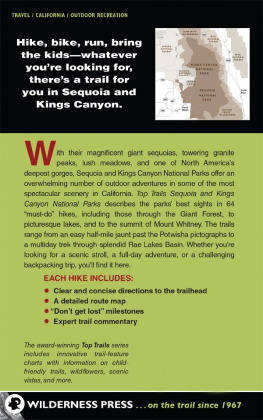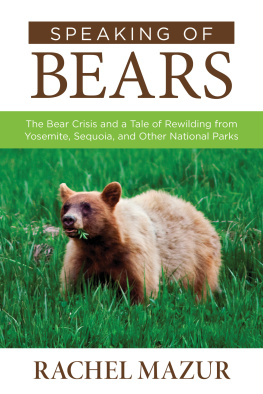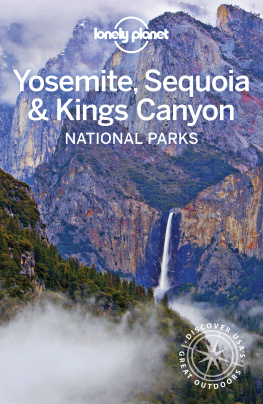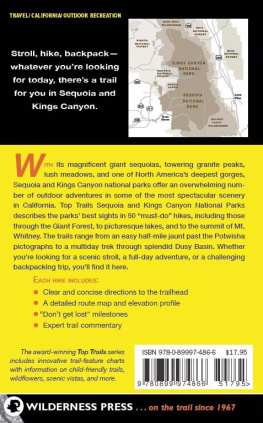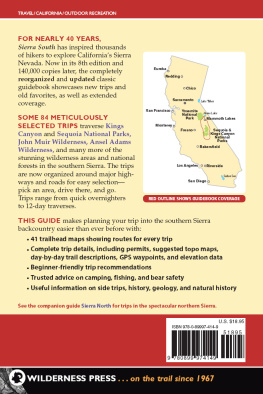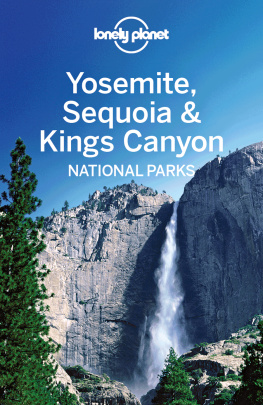About the Author
Laurel Scheidt, born and raised in the central San Joaquin Valley, considers the Sierra Nevada her home away from home. She has traveled many of the trails on both sides of the mountain range, from Lake Tahoe to Lake Isabella, and is a member of the Audubon Society, the Nature Conservancy, the Sierra Club, and the Cornell Laboratory of Ornithology. After living most of her life in Fresno, she now resides in Modesto, California, with her husband, Scott.
Appendix A: For More Information
Sequoia and Kings Canyon National Parks
47050 Generals Hwy.
Three Rivers, CA 93271
Wilderness permits, road and weather conditions, and general information
(559) 565-3341 (24 hours)
nps.gov/seki/
Sequoia Natural History Association
HCR 89 Box 10
Three Rivers, CA 93271
(559) 565-3759
Fax: (559) 565-3728
sequoiahistory.org
Inyo National Forest
Eastern Sierra Interagency
Visitor Center
Intersection of US 395 and SR 136
2.0 miles south of Lone Pine, CA 93545
(760) 876-6200
fs.usda.gov/inyo/
For Mount Whitney reservations:
recreation.gov
White Mountain Ranger Station
798 N. Main St.
Bishop, CA 93514
(760) 873-2500
Wilderness Permit Office
Reservations and Changes Only (open Mon to Fri from 1 to 5 p.m.):
(760) 873-2483
Fax: (760) 873-2484
Wilderness Information:
(760) 873-2485
fs.usda.gov/main/inyo/passes-permits/recreation
General Recreation Information:
(760) 873-2408
fs.usda.gov/recmain/inyo/recreation
Sequoia National Forest
Hume Lake Ranger District
35860 E. Kings Canyon Rd.
Dunlap, CA 93621
(559) 338-2251
Fax: (559) 338-2131
fs.usda.gov/main/sequoia/
Sierra National Forest
Pine Ridge Ranger District
PO Box 559
Prather, CA 93651
(559) 855-5360
fs.usda.gov/main/sierra/
For Road and Weather Conditions:
California Department of Transportation Highway Conditions: (559) 445-5647 or (800) 427-7623
dot.ca.gov
For Maps:
Global Map Store
5091 N. Fresno St.
Fresno, CA 93710
(559) 224-9831
US Geological Survey
Information Services
PO Box 25286
Denver, CO 80225-9916
(800) USA-MAPS or (800) HELP-MAP
Fax: (303) 202-4693
topomaps.usgs.gov/
For acceptable (SequoiaKings Canyon National Parksapproved) bear-resistant food-storage containers:
Garcia Machine, Backpacking Canister
14097 Ave. 272
Visalia, CA 93292
(559) 732-3785
backpackerscache.com
Specifications: 8-inch diameter by 12-inch length cylindrical canister
Weight: 2.7 pounds of molded plastic
Model: 812-C
This canister is also available through the Sequoia Natural History Association and outdoor retail outlets. It features two large screw latches on the lid that can be opened by using a coin, key, or screwdriver, then pushing a button to easily pop up the canisters lid. Available for purchase or rental.
Wild Ideas
PO Box 60813
Santa Barbara, CA 93160
(805) 693-0550
wild-ideas.net
Specifications: 9-inch diameter by 15 1/4-inch length cylindrical canister.
Weight: More than 1 pound.
This canister features three large screw latches that can be twisted open with a coin, key, or screwdriver. The lid is flush and requires some manipulation to open. Available for purchase or rental.
Appendix B: Sources and Further Reading
Browning, Peter. Place Names of the Sierra Nevada: From Abbot to Zumwalt. Berkeley, CA: Wilderness Press, 1986.
Editors of Readers Digest. North American Wildlife. Pleasantville, NY: Readers Digest Association, 1982.
Farrand, John, Jr. National Audubon Society Pocket Guide: Familiar Mammals of North America. New York: Alfred A. Knopf, 1988.
Grater, Russell K. Discovering Sierra Mammals. El Portal, CA, Yosemite Association and Sequoia Natural History Association, Inc. in cooperation with the National Park Service Department of the Interior, 1978.
Hartesveldt, R. J., H. T. Harvey, H. S. Shellhammer, and R. E. Stecker. Giant Sequoias. Three Rivers, CA: Sequoia Natural History Association, Inc., 1981.
Johnston, Hank. They Felled the Redwoods. Fish Camp, CA: Stauffer Publishing, 1996.
Little, Elbert L. The Audubon Society Field Guide to North American Trees: Western Region. New York: Alfred A. Knopf, 1980.
National Park Service Division of Publications. Sequoia and Kings Canyon (Handbook 145). Washington, DC: Department of the Interior and US Government Printing Office, 1993.
Palmer, John J. SequoiaKings CanyonThe Continuing Story. Las Vegas: K. C. Publications, Inc., 1990.
Schneider, Bill. Bear Aware: The Quick Reference Bear Country Survival Guide, 4th edition. Guilford, CT: FalconGuides, 2012.
Spellenberg, Richard. The Audubon Society Field Guide to North American WildflowersWestern Region. New York: Alfred A. Knopf, 1979.
Stocking, Stephen K., and Jack A. Rockwell. Wildflowers of Sequoia and Kings Canyon National Parks. Three Rivers, CA: Sequoia Natural History Association, Inc., 1989.
Storer, Tracy I., and Robert L. Usinger. Sierra Nevada Natural History. Berkeley: University of California Press, 1963.
Tweed, William C. Kaweah Remembered: The Story of the Kaweah Colony and the Founding of Sequoia National Park. Three Rivers, CA: Sequoia Natural History Association, Inc., 1986.
Tweed, William C. SequoiaKings Canyon: The Story Behind the Scenery. Las Vegas: K. C. Publications, Inc., 1980.
Tweed, William C., and Dilsaver, Lary M. Sequoia Yesterdays: Centennial Photo History. Three Rivers, CA: Sequoia Natural History Association, Inc., 1990.
Udvardy, Miklos D. F. The Audubon Society Field Guide to North American Birds: Western Region. New York: Alfred A. Knopf, 1977.
Appendix C: Hikers Checklist
Hiking equipment does not have to be new or fancy (or expensive), but make sure you test everything before you leave home.
Equipment recommended for day trips follows:
Day pack or fanny pack
Drinking water
Insect repellent
Tissue
Toilet paper
Toilet trowel
Small flashlight or headlamp
Extra batteries for flashlight
Maps and field guides
Compass
Watch
Sunscreen and lip balm
Sunglasses
Cap or hat with brim
Fleece jacket or woolen sweater
Long-sleeve shirt
Sturdy hiking boots (waterproof is best)
Light, natural-fiber socks
Lightweight windproof coat
Lightweight hiking shorts or long pants
Mittens or gloves
Rain gear
Small first-aid kit, with bandages and antibacterial ointment for cuts, moleskin for blisters, and aspirin or anti-inflammatory for aches and pains
Small scissors or Swiss Army knife with scissors
Camera and film
Notebook and pencils
Binoculars
Food: Bring high-energy snacks for lunching along the way. Dont overburden yourself with too much food.
Equipment recommended for overnight trips follows:
Tent and waterproof fly
Garbage sacks
Sleeping bag (20 degrees Fahrenheit or warmer)
Zipper storage bags
Stuff sacks
Sleeping pad
Paper towels
Cooking pots and pot holder
Bear canister
More water bottles
Full-size pack
Cup, bowl, and eating utensils
Personal toilet kit
Lightweight camp stove and adequate fuel
Clothing: In general, strive for natural fibers such as wool, and earth tones instead of bright colors. Dig around in the closet for something dull. Your wilderness partners will appreciate it. Try out clothing before leaving home to make sure everything fits loosely with no chafing. In particular, make sure your boots are broken in, lest they break you on the first day of the hike.


